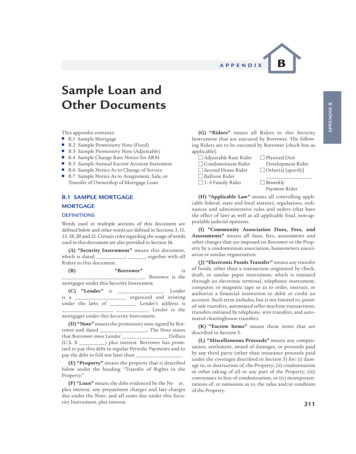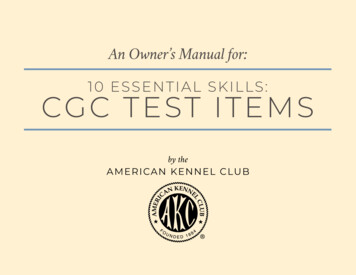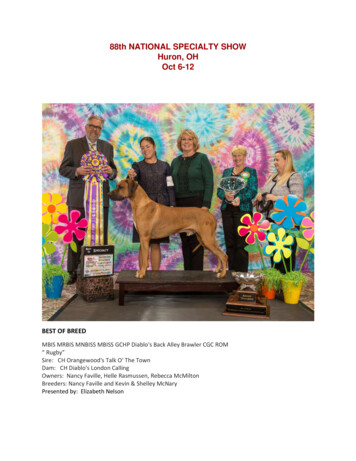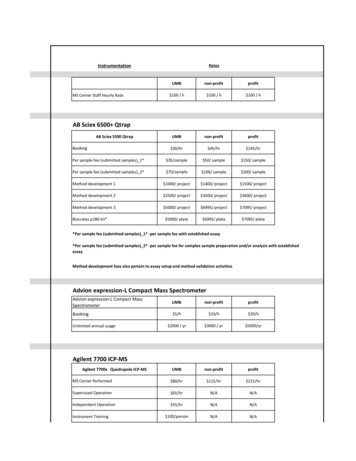
Transcription
A Sample CGC TrainingPlanOriginally disseminated at the Jan 2013 GDCNCMeeting - Permission to shareRecently the AKC has added the Canine GoodCitizen program to the titling program. Thismeans that if your dog successfully completes aCGC test, it may now have the title CGCfollowing its name. Many Great Dane ownershave participated in this CGC certificate programin the past; however, for anyone who might beinterested in working towards a CGC title, theGDCNC has prepared a sample training plan thatmay help you and your dog train towards theskills needed to successfully complete the CGCtitle.As you know, there are many different approaches to teach a dog to perform desiredbehaviors. The approaches offered below are not the only way to train your dog—nor arethey necessarily the right way for you and your dog. They are offered as one option; it isnot our intent to advocate for one training program over another.Many people find that attending a training class with a knowledgeable trainer ispreferable to training alone; however, sadly we can’t all find the time to attend classes.The ideas provided below are in case you aren’t able to train in a training class and youwould like to pursue the AKC CGC title and will have to train alone.The most commonly asked question regarding dog training is, “How long will it take formy dog to be ready?” .and the answer is It depends. “It depends” on many factorssuch as your dog’s current level of “training”, your skill as a trainer, your dog’s desire totrain, the time you can commit to training, etc In the pages below, the GDCNC has offered a training outline based on training for theskills necessary for the CGC test.Skills for CGC TestItem 1: Accepting a Friendly StrangerItem 2: Sitting Politely for PettingItem 3: Appearance and GroomingItem 4: Out For a Walk
Item 5: Walking Through a CrowdItem 6: Sit and Down on Command/ Staying in PlaceItem 7: Coming When CalledItem 8: Reaction to Another DogItem 9: Reaction to DistractionsItem 10: Supervised SeparationRecommended Training PlanTRAINING SET ONE:Your first sessions should focus on the following skills: Walking on a loose lead and learninghow to sit.Sit: If your dog doesn’t know how to sit, you may want toteach the sit in the following fashion: Start in an area withlimited distractions that your dog knows well. Place your dogon a leash and remove most of the slack from the leash. Holda treat in your hand between your thumb and your index andmiddle fingers. Hold that treat in front of the dog’s nose.Slowly lift the treat above your dog’s head and the dog willlook up. As the dog looks up, continue to keep the cookieslightly out of her reach. As your dog continues to look up,she should sit. As soon as her bottom touches the floor, giveher the cookie and praise her. Note: don’t say sit yet. Oncethe dog has mastered the “cue” of you luring them with thecookie, then you may add the command for sit. Once the dogsits in an environment withwhich she is familiar, beginto change the environment to the front yard, drive way, dogclass etc.Walking on a Loose Lead: If your dog doesn’t walk on a looselead, you may want to teach this skill by breaking it up intotwo main parts. Part One: Stand beside you without pullingon the leash & Part Two: Moving with you without pulling onthe leash.Part One: You may wish to have some treats (or kibble)handy for teaching this skill. Stand with your dog on leash in
a familiar area. When the dog stands without pulling AND is near enough to you that you cantouch the dog’s head without moving AND is looking at you, you may praise the dog and giveher a treat. If she pulls on the leash OR she is not close enough that you can touch her OR sheis not paying attention to you, say nothing and wait her out. As soon as she does all threethings, praise her and give her a treat. Note: if the dog pulls on the leash, don’t say anything.Wait until the dog releases the tension on the leash and then praise.Part Two: Moving with a loose leash. You may wish to havesome treats (or kibble) handy for teaching this skill. You willwant to have the dog on a leash and in a familiar area. Say thedog’s name and your walk command. If the dog walks besideyou without pulling, for one or two steps, stop and praise the dog.Try to give the dog the treat while she is still on your left sidewalking nicely. Try not to let the dog move to the front of you totake the treat. Gradually work up from one step to 10-15 steps onloose leash walking with limited distractions.Don’t progress until your dog will sit in an area withlimited distractions 75% and you can walk 10 steps without thedog pulling on the leash.TRAINING SET TWO:In your second set of training sessions, you should continue the focus on the sit and the walkon the loose lead .and add in the following behaviors: allowing the dog’s ears, feet and bodyto be touched, sit/stay and down.Down: If your dog doesn’t know how to “down”, you may want to teach this skill in thefollowing fashion. Start with your dog on leash and in a sit. Hold a treat between your thumb,index and middle fingers with your palm facing the floor. With the dog in a sit, take the treatand move it down the dog’s body from the nose to the underside of their belly. This action willcause the dog’s nose to move towards the floor and then the dog will scoot back into a down—or—to pop her hind end up. If your dog pops her hind end up try the next approach. Instead ofpulling the treat from the nose to the underside of the body, pull the treat from the nose straightdown to the floor—making a right angle with the floor from her nose—and then pull the treatacross the floor away from the dog. This will cause the dog’s nose to drop towards the floorand she will lower herself toward the floor and fold forward into a down.
Stay: If your dog doesn’t know how to stay, you may want to introduce the skill in thefollowing fashion. Start with your dog on leash and in an area free of distractions. Ask yourdog to sit or down. Using a hand signal (such as placing your hand in front of your dog’s faceor swinging your hand from right to left in front of the dog) tell the dog to stay and take onestep LATERALLY away from the dog. If the dog doesn’t move, go back to the dog and praisethe dog. If the dog does move, put the dog back into the position it was in and don’t take astep away, but move in place .bounce up or down, move your hand, bend your knees .andthen praise the dog if she doesn’t move. Work up to one step forward, laterally and behind thedog before adding more distance. If the dog moves, then place the dog back in the position itwas in before you left it and try again.Don’t progress until your dog will perform the following tasks: Sit/Stay as you take 10 forward steps AND return to the dog Down 75% of the time on command Walk on a loose lead in familiar placesTRAINING SET THREE:In your third set of training sessions, you should continue the focus on the behaviors that youhave worked on previously and add coming when called.Coming when called: If your dog doesn’t know how to come—each and every time you callher—you may want to teach the skill in the following fashion. Start with your dog on a leash(between 6 and 15 feet long) and in an area free of distractions. Ask your dog to sit and stay.Walk to the end of the leash and say your dog’s name and using a high pitch voice tell the dogto come. You may want to step backwards until your dog reaches you. When the dog arrivesto you praise the dog lavishly. You may want to use the dog’s entire meal for a few days whenteaching this skill.Note: It is important to NOT punish the dog when you call it back to you. If the dog doesn’tcome to you, use the leash and “reel” her to you while saying “come”. Praise her when shereaches you and try again.
Don’t progress until your dog will perform the following tasks: Sit/Stay as you take 25 forward steps AND return to the dog Down/Stay as you take 15 forward steps AND return to dog 75% of the time Come when called—on leash—from a distance of 15-20 feetTRAINING SET FOUR:By this session –the fourth training session— you and your doghave been introduced to all the skills tested in a CGC test.However, you are likely not ready yet. Over the next fewweeks, you will need to focus on adding distractions andpracticing in different areas.It is at this point in most training programs that owners wish tohave tee-shirts made that “say” .but my dog does it perfectlyat home! Unlike people, dogs don’t appear to be able togeneralize their skills in new areas without practice. So don’tbe disheartened if your dog will sit and stay perfectly at yourhouse or in your yard and then acts like you haven’t ever taughther anything when you try this skill out on the town.This week you need to focus on adding distractions to all of your training. Some trainingclasses offer “drop in” sessions where you can come with your dog and participate in one nightof class. Even if you can’t find this opportunity, consider going to local parks, practicing at ashow, the grocery store parking lot, a playground, etc. Be creative and hit the road!Don’t progress until your dog will perform the following tasks well in unfamiliar areaswith distractions. Please make sure your dog is on a leash during these exercises. If you don’thave one long leash, consider making a longer leash out of a few shorter ones. Additionally,you may wish to return to treating/praising the dog liberally during the next few trainingsessions. Sit on command 90% of the time Down on command 90% of the time Sit/Stay as you take 10 forward steps AND return to the dog 75% of the time Down/Stay as you take 5 forward steps AND return to dog 75% of the time Loose leash walking with distractions Come when called—on leash—from a distance of 5-10 feet
TRAINING SET FIVE:During this session, you will want to continue practicing yourskills with distractions and you will need to have “unfamiliar”people to assist you with your training. During these sessions,you will practice the supervised separation, greeting whileseated, and allowing the dog to be touched by someone otherthan you.For the supervised separation, you will want your friend tohold your dog on leash and you will want to walk away fromthe dog. For your first few sessions, you will want to stay insight of the dog. Over time, you will build up more distanceand increase the duration of these sessions. The goal for thetest is a 3 minute supervised separation with you out of sight.Don’t progress until your dog will perform the following tasks with distractions in anunfamiliar area. Don’t be afraid to treat and praise liberally during these sessions. Sit/Stay as you take 25 forward steps AND return to the dog Down/Stay as you take 15 forward steps AND return to dog 75% of the time Come when called—on leash—from a distance of 15-20 feet Supervised Separation (with you in sight) for 90 seconds Dog should perform the first two exercises—Greeting a Friendly Stranger and Sitting forPetting—according to the CGC guidelines Loose leash walking with distractionsTRAINING SET SIX:During this session, you will want to continue practicing your skills with distractions and youwill still need to have “unfamiliar” people to assist you with your training.During these sessions, you will pick the areas where you and your dog need extra practice andfocus on those skills.
Don’t progress until your dog will perform the following tasks with distractions in anunfamiliar area. Don’t be afraid to treat and praise liberally during these sessions. Sit/Stay as you take 25 forward steps AND return to the dog 90% of the time Down/Stay as you take 15 forward steps AND return to dog 90% of the time Come when called—on leash—from a distance of 20 feet Supervised Separation (with you in sight) for 3 minutes and with you out of sight for 30seconds Loose leash walking with distractions—MUST INCLUDE—other dogs.TRAINING SET SEVEN:Not much has changed in the last few training sessions. Youare likely noticing a pattern by now that will continue fromnow until when you are ready to take the CGC test. During thissession, you will want to continue practicing your skills withdistractions and you will need to have “unfamiliar” people toassist you with your training. During these sessions, you willpick the areas where you and your dog need extra practice andfocus on those skills. By this point in the training program, youshould feel confident that your dog is able to successfullycomplete each of the activities in the CGC test.However, as we all know .getting here doesn’t mean you aredone. You will need to continue practicing and training untilthe CGC test .but the good news is that you have moved intoreminder mode and that your dog likely knows that you aregoing to “work” and she is going to get treats while you are out.You should focus on practicing in areas where you have distractions—especially other dogs.If you two are having a good time training, you might want to consider moving onto the skillsrequired for Rally Novice, K9 Nose Work or some other activity that you both enjoy.Happy Training!
things, praise her and give her a treat. Note: if the dog pulls on the leash, don't say anything. Wait until the dog releases the tension on the leash and then praise. Part Two: Moving with a loose leash. You may wish to have some treats (or kibble) handy for teaching this skill. You will want to have the dog on a leash and in a familiar area.











